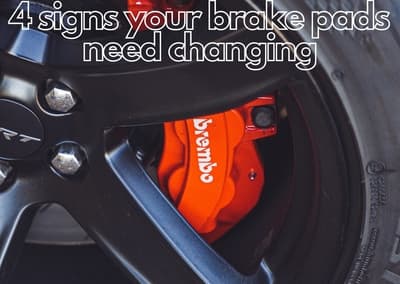4 signs your brake pads need changing
Your brakes are an integral part of the safety system in your car. They are often the first thing checked in an MOT and are necessary for the basic function of a car or van. With all this being said, brakes must be maintained and replaced when necessary. However, a lot of drivers are unaware of the signs that their brake pads need changing. The brake pads are attached to the brake caliper and are responsible for creating friction with the brake disc to bring the vehicle to a stop. Without functioning brake pads then the brake disc, calipers and rotors will begin to wear away. In this article, we are going to give you 4 signs that your brake pads need changing.

Squeaking coming from the brakes
The first sign that your brake pads need changing is a noticeable squeaking sound coming from the wheel arches. This sound may be perfectly normal in wet weather conditions. However, if you notice this noise continually it is a sign that the brake pads have worn down and need replacing. In order to diagnose this properly, you will need to get your brakes looked at by a professional. You can book brake check at your local National Tyres and Autocare branch clicking on the related article below.
Related: Check my brakes
Brake pad dashboard warning light
Similar to when you are in need of an oil change, a light will appear on your dashboard indicating that your brake pads need changing. This feature may only appear on more modern cars, as they have been built with newer technology that has sensors on the brake pads. This means that when your brake pads are running low a warning light will appear. If you see this warning light on your dashboard you should make it your priority to get these brake pads changed, as it can have an impact on the effectiveness of your brakes.
Related: Car dashboard warning lights
A vibrating brake pedal
A third indication that your brake pads will need changing is if you feel your brake pedal vibrating. The vibrations are caused by the brake pads catching on the wheel, due to them being so thin. The vibrations will be most noticeable as you press your brake pedal down. You may also notice the brake pedal feeling unsteady, as well as the vibrations, indicating you need an immediate brake pad replacement.
Brake pads look thin
The final indication that your brake pads need replacing is by inspecting them visually. You can check the condition of your brake pads by looking through the wheel. If the brake pads are less than a quarter of an inch thick, this means that they need changing. You can find the exact location of the brake pads by looking through the spokes of the wheel. The brake pads are located on the rotor of the wheel.
How often should I change my brake pads?
It is recommended that you get your brake pads changed every 50,000 miles. You may need to change them more often depending on how regular you drive and the conditions in which you drive your vehicle. You should be aware of the signs listed above and get your brake pads changed if you notice any problems, despite the fact that you may have done under 50,000 miles.
If you have noticed any of the problems above or you are due to have your brake pads changed then you can book an appointment at your local National Tyres and Autocare branch and get a professional inspect them straight away. We also now have a promotion of 20% off brake repairs including pads, discs, shoes, drums, cylinders and calipers. Please note this promotional is an in-branch only discount.
Did you enjoy this blog post? |41 people found this review helpful



 Sign up for SPECIAL OFFERS
Sign up for SPECIAL OFFERS
